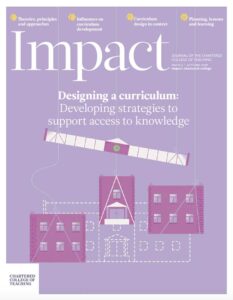Taking a long view: Designing curricula for pupils with Down syndrome and other learners with speech, language and communication needs (SLCN) working below level 2

This article discusses curriculum content and structure for pupils with a distinctive profile: those who have a learning disability, whose learning attainments do not match expectations for their chronological age, and who face additional challenges in expressive communication, so that it is difficult for them to demonstrate (and for education staff to assess) knowledge and understanding through talking or writing. This profile is associated with diagnoses such as Down syndrome, Trisomy 9, Developmental Language Disorder with learning disability, and some presentations of autism spectrum conditions. It draws on 25 years of experience as a speech and language therapist, working with children with this profile, their families and their schools.
Towards tailored curricula
InclusionAn approach where a school aims to ensure that all children ... More involves a ‘commitment to ensuring all children are educated together, with support for those who require it to access the full curriculum, contribute and participate in all aspects of school life’ (Hare, 2018). Children with Down syndrome benefit significantly from inclusion in mainstream schools, with improved speech, language and communication skills compared to those educated in segregated settings (Buckley et al., 2006). (See Figure 1 for the profile of learning difficulties associated with Down syndrome, and Figure 2 for an outline of their additional development needs). However, designing and delivering relevant and effective curricula for these pupils as well as others with speech, language and communication needs (SLCN), can be difficult. This is predicated by a history of exclusion from education lasting until the late twentieth century. The Warnock Report (1978) ‘challenged dominant assumptions that there were “two types of children, the handicapped and the non-handicapped” and that the categorisation of impairment was a justification for “special” provision’ (Armstrong, 2007). New legislation in 1981 stated that school placement (special or mainstream) should be in line with assessed abilities, rather than simply based on diagnosis, opening up the possibility of going to mainstream local schools rather than automatically being placed in special schools.

There are examples of people with Down syndrome attending mainstream schools in the UK prior to this, and accounts of their schooling highlight ordinary practices and expectations, rather than adaptations. For example, Nigel Hunt, born in 1947 wrote of his secondary school: ‘We had a lot of things to do until the examinations came along, until I became fed up with them. Actually I had to put up with them. I got most of them right and the rest I couldn’t know.’(Hunt, 1967) Simply opening the doors did not necessarily make schools work for pupils with Down syndrome, and the hope that the presence of children with additional needs would drive better care was not realised.
Contemporary syndrome-specific approaches
The first Code of Practice for Special Educational Needs and Disabilities (SEND), arising from the 1993 Education Act, set out practical guidance on identifying, assessing and making provision for children with SEND, introducing SENCOs (special educational needs coordinators) and IEPs (individual education plans). While strengthening provision, this also reinforced the notion that these pupils required specialist staffing and a separate curriculum, perpetuating the idea a student with disabilities is a ‘square peg to be squeezed into a round hole’ (Sayers, 2016).
The Down syndrome community advocates that practitioners should have an understanding of the needs and challenges that pupils face, and of tried and tested strategies with a strong research basis (Buckley, 2000). The Down’s Syndrome Association Primary Education Pack (Down’s Syndrome Association, 2014) and All Party Parliamentary Group on Down Syndrome (APPGDS) Good Practice Guidelines for Education 2012 advocate differentiation of curriculum plans for the class or year group, adjusting class activities and learning goals in line with the needs of the individual. Across subjects and phases, interventions to support those with Down syndrome need not be expensive or time-consuming. Making reasonable adjustments to the classroom environment might involve providing a visually-impaired child with printed handouts in larger print; or a student with dyslexia with handouts on different coloured paper (Sayers, 2016).
Families are often interested in life skills, and how they can be taught and improved through accessing the curriculum in mainstream settings. There are opportunities to address these concerns by teaching life skills for the benefit of all students. For example, in primary schools, life skills can be taught by relating numeracy to time, money, and activities such as shopping, cooking, weighing and measuring (APPGDS, 2012). Similarly, within secondary schools food tech offers training and opportunities around the safe use of equipment, storing food and menu planning and food preparation skills. Science and design and technology can also include teaching about hazards, risks and harm-minimisation (heat, acids and alkalis, sharp tools, safety equipment and keeping your body healthy).
Fitting it all in
What about teaching the full curriculum and preparing for GCSEs? The APPGDS Good Practice Guidelines for Education (2012, p. 28) state, ‘Many pupils with Down syndrome will be capable of taking GCSEs, from one to five or more for the most capable.’ The new SEND code of practice (DfEDepartment for Education - a ministerial department responsi... More, 2015) has extended education provision for children to 25 and there is increasing emphasis and support for pursuing accreditation in the FE sector, which is usually better positioned to offer more forms of accreditation through foundation courses and/or practical qualifications in areas such as performing arts, hospitality, hair and beauty. If it is not possible to offer externally validated accreditation at the end of Key Stage 4, a portfolio profile can evidence the pupil’s skills, achievements and aptitudes, continuing the approach of the Early Years Foundation Stage profiling for our pupils who require an individualised, visual approach.
Varying the timing of the selection of options (APPGDS Good Practice Guidelines for Education, 2012) can reduce the demands of the Key Stage 3 curriculum, where pupils drop subjects from their class timetable (e.g. second modern foreign language or reducing triple science) in Year 7, 8 or 9, opening up timetable slots for extra work on literacy, numeracy, PSHE or extra study to support other subjects.
The challenge of teaching and adapting a mainstream curriculum underpins social inclusion in school and affords opportunities for life-long learning. For more information on how to achieve this, see the All Party Parliamentary Group on Down Syndrome (APPGDS) Good Practice Guidelines for Education, 2012.
References
About the Author
My Name is Kieran Briggs and I'm a web developer working for the Chartered College of teaching sdl;kfjasdl;fj l;asdkfj as;dlfjasd kl;
-
This author does not have any more posts.










